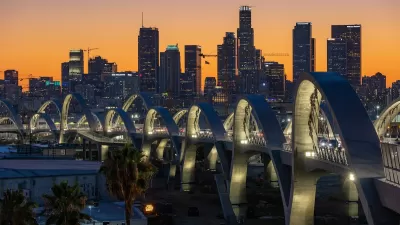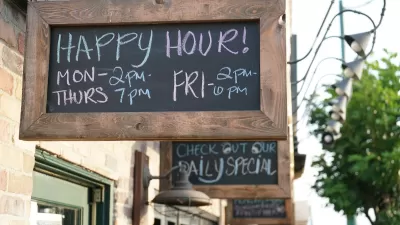Mirroring New Orleans’ French Quarter or the Las Vegas Strip, some cities are experimenting with loosening open container laws in certain commercial areas.

While most of the United States has strict laws against ‘open containers’ of alcohol outside of bars and restaurants, some cities are experimenting with the creation of ‘drinking zones’ that allow patrons to carry drinks around certain designated commercial areas. “The hope is that by allowing people to grab a drink and linger, they’ll spend more time and money downtown.”
In some cases, states such as North Carolina and Ohio are relaxing regulations to let cities create these zones, explains Kevin Hardy in Stateline. “They aim to revitalize downtown cores hollowed out by the changing nature of retail and the post-pandemic loss of office workers.”
“Aside from bringing foot traffic to shops and restaurants, officials say the success of the new districts reveals the need to update antiquated liquor laws that long banned public consumption in most places to try to reduce public intoxication and drunken driving.”
Hardy describes efforts in several cities and states, noting that, in most cases, the districts face little local opposition. Meanwhile, business owners report seeing increased activity.
FULL STORY: ‘I felt so naughty’: New open carry alcohol laws boost downtowns

Trump Administration Could Effectively End Housing Voucher Program
Federal officials are eyeing major cuts to the Section 8 program that helps millions of low-income households pay rent.

Planetizen Federal Action Tracker
A weekly monitor of how Trump’s orders and actions are impacting planners and planning in America.

Ken Jennings Launches Transit Web Series
The Jeopardy champ wants you to ride public transit.

Washington Legislature Passes Rent Increase Cap
A bill that caps rent increases at 7 percent plus inflation is headed to the governor’s desk.

From Planning to Action: How LA County Is Rethinking Climate Resilience
Chief Sustainability Officer Rita Kampalath outlines the County’s shift from planning to implementation in its climate resilience efforts, emphasizing cross-departmental coordination, updated recovery strategies, and the need for flexible funding.

New Mexico Aging Department Commits to Helping Seniors Age ‘In Place’ and ‘Autonomously’ in New Draft Plan
As New Mexico’s population of seniors continues to grow, the state’s aging department is proposing expanded initiatives to help seniors maintain their autonomy while also supporting family caregivers.
Urban Design for Planners 1: Software Tools
This six-course series explores essential urban design concepts using open source software and equips planners with the tools they need to participate fully in the urban design process.
Planning for Universal Design
Learn the tools for implementing Universal Design in planning regulations.
Heyer Gruel & Associates PA
Ada County Highway District
Institute for Housing and Urban Development Studies (IHS)
City of Grandview
Harvard GSD Executive Education
Toledo-Lucas County Plan Commissions
Salt Lake City
NYU Wagner Graduate School of Public Service





























